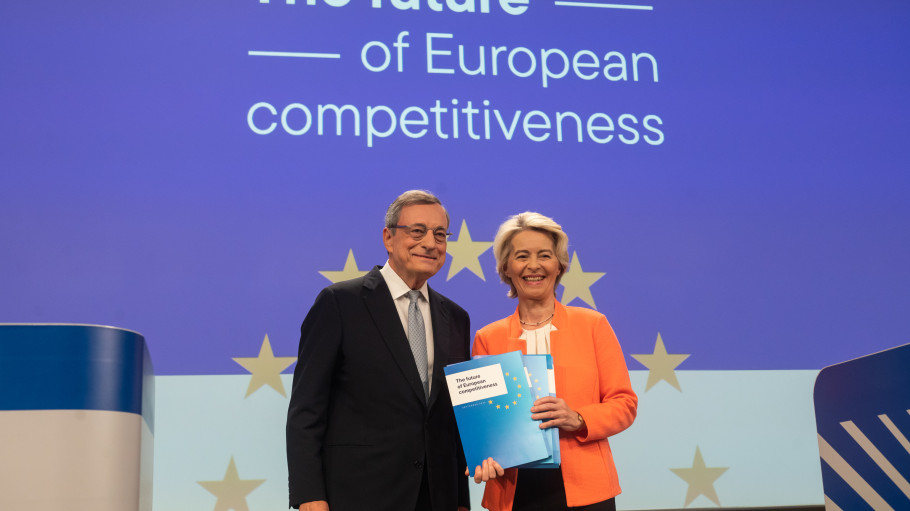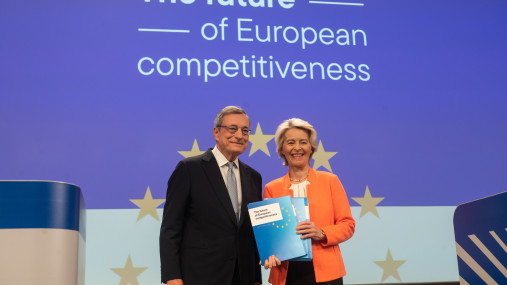
Press releases » Concrete implementation of Draghi’s competitiveness cure urgently needed to ensure business case for industry in Europe, says EUROFER
Concrete implementation of Draghi’s competitiveness cure urgently needed to ensure business case for industry in Europe, says EUROFER
Downloads and links
Recent updates

Brussels, 10 September 2024 – The Draghi Report thoroughly identifies the bottlenecks to both the EU industry's decarbonisation and competitiveness. The proposed recommendations for energy-intensive industries, including on energy, trade, carbon leakage, financing and lead markets, should be integrated into the upcoming Clean Industrial Deal and implemented with concrete measures as a matter of urgency. Alignment across different policies is crucial, and should be accompanied by sector-specific initiatives to enable the transition of each industry including steel, asks the European Steel Association.
“We fully share Mr. Draghi’s diagnosis of the root causes and general remedies for Europe’s loss of competitiveness. There is no time to lose, Europe’s resilience and prosperity are at stake. The lack of a business case in Europe for the steel industry and its manufacturing value chains - which are critical not only for innovation, decarbonisation and high-quality jobs but for the whole EU economy - needs to be immediately addressed with concrete measures”, said Axel Eggert, Director General of the European Steel Association (EUROFER). “The EU’s new industrial strategy requires a strong dose of pragmatism, and should follow the lines of Mr. Draghi’s recommendations. Each energy-intensive industry requires a granular approach to enable decarbonisation while levelling the playing field with international competitors. It is time for a set of steel-specific measures - a European Steel Pact - to be part of the broader Clean Industrial Deal announced by Commission President Ursula von der Leyen”, stressed Mr. Eggert.
The Draghi Report recognises a series of issues the European steel industry has also repeatedly brought forward:
- Climate policy: the phasing out of free allowances and the replacement of the current Emissions Trading System (ETS) with the Carbon Border Adjustment Mechanism (CBAM) entail high delocalisation risks. Additional fixes to make CBAM effective before its start coupled with close monitoring to avoid circumvention and resource shuffling, a solution for EU exports and the extension of CBAM to downstream sectors are needed.
- Energy policy: despite the growing share of renewables in the grid, households and businesses do not yet benefit from low energy prices, crreating a competitive disadvantage for EU industries vis a vis US and China. While a number of proposals are recommended to address this issue and lower energy prices, the European steel industry expects urgent measures that lead to this objective in the short term.
- Investment & financing, and lead markets for clean technologies: there are insufficient financial incentives and resources for the industrial transition, as the EU Innovation Fund alone is not enough, while only a fraction of ETS revenues is currently invested in the decarbonisation of energy-intensive sectors such as steel. Support should be provided for both capital expenditure (CAPEX) and operational costs (OPEX) via the earmarking of ETS allowances. The Hydrogen Bank and Carbon Contracts for Difference should also be used to support the transition, as they ensure fair competition in the single market. Moreover, despite its ambition to maintain manufacturing capacity for clean technologies, the EU is increasingly relying on imports to satisfy its rising demand. The introduction of a minimum quota in public procurement and auctions other types of rewards for locally produced clean tech products and components is strongly supported. Clean steel made in the EU is a core material for cleantech value chains’ resilience.
- Trade policy: An unlevel playing field in energy-intensive industries such as steel can have repercussions for many downstream industries, which are crucial for the EU’s open strategic autonomy. In light of the strong rise in imports, the persistent increase in global steel overcapacity and restrictive trade policy in third countries, the EU should maintain its capability to react quickly to market distortions while also working on structural solutions.
“The European steel sector is a litmus test for the entire EU industry’s health. We rang the alarm bell several years ago. Now the symptoms of deindustrialisation have spread to the value chain. Decarbonisation targets should be reached without plant closures but, as Mario Draghi said, we need radical change in EU policies to reboot our competitiveness. This is the last train for Europe’s decarbonisation and prosperity”, concluded Mr. Eggert.
Photo credits: European Union, 2024
Contact
Lucia Sali, Spokesperson and Head of Communications, +32 2 738 79 35, ([email protected])
About the European Steel Association (EUROFER)
EUROFER AISBL is located in Brussels and was founded in 1976. It represents the entirety of steel production in the European Union. EUROFER members are steel companies and national steel federations throughout the EU. The major steel companies and national steel federation of Turkey, Ukraine and the United Kingdom are associate members.
The European Steel Association is recorded in the EU transparency register: 93038071152-83.
About the European steel industry
The European steel industry is a world leader in innovation and environmental sustainability. It has a turnover of around €191 billion and directly employs around 303,000 highly-skilled people, producing on average 140 million tonnes of steel per year. More than 500 steel production sites across 22 EU Member States provide direct and indirect employment to millions more European citizens. Closely integrated with Europe’s manufacturing and construction industries, steel is the backbone for development, growth and employment in Europe.
Steel is the most versatile industrial material in the world. The thousands of different grades and types of steel developed by the industry make the modern world possible. Steel is 100% recyclable and therefore is a fundamental part of the circular economy. As a basic engineering material, steel is also an essential factor in the development and deployment of innovative, CO2-mitigating technologies, improving resource efficiency and fostering sustainable development in Europe.

Brussels, 27 November 2024 – The European steel industry is at a critical juncture, facing irreversible decline unless the EU and Member States take immediate action to secure its future and green transition. Despite repeated warnings from the sector, the EU leadership and governments have yet to implement decisive measures to preserve manufacturing and allow green investments across Europe. Recent massive production cuts and closure announcements by European steelmakers show that time has run out. A robust European Steel Action Plan under an EU Clean Industrial Deal cannot wait or manufacturing value chains across Europe will simply vanish, warns the European Steel Association.
Brussels, 12 November 2024 - Ahead of Commissioner-Designate Séjourné’s hearing in the European Parliament, European steel social partners, supported by cross-party MEPs, jointly call for an EU Steel Action Plan to restore steel’s competitiveness, and save its green transition as well as steelworkers’ jobs across Europe.
Brussels, 29 October 2024 – The European steel market faces an increasingly challenging outlook, driven by a combination of low steel demand, a downturn in steel-using sectors, and persistently high import shares. These factors, combined with a weak overall economic forecast, rising geopolitical tensions, and higher energy costs for the EU compared to other major economic regions, are further deepening the downward trend observed in recent quarters. According to EUROFER’s latest Economic and Steel Market Outlook, apparent steel consumption will not recover in 2024 as previously projected (+1.4%) but is instead expected to experience another recession (-1.8%), although milder than in 2023 (-6%). Similarly, the outlook for steel-using sectors’ output has worsened for 2024 (-2.7%, down from -1.6%). Recovery projections for 2025 are also more modest for both apparent consumption (+3.8%) and steel-using sectors’ output (+1.6%). Steel imports share rose to 28% in the second quarter of 2024.